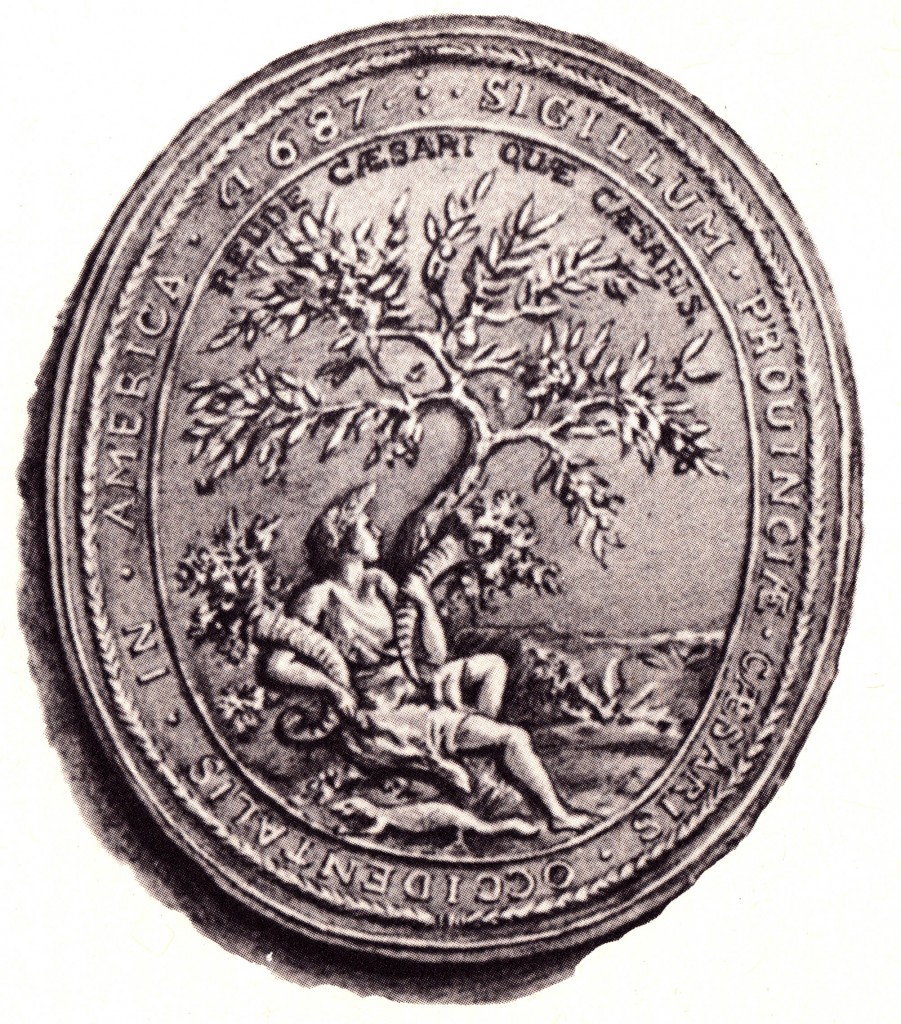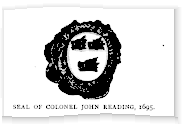Back Track to 1687
While visiting the website “West Jersey and South Jersey Heritage,” I found this picture of the seal of West Jersey. It took me by surprise.

This picture of the great seal can be found in John E. Pomfret’s The New Jersey Proprietors and Their Lands, page 38, next to the great seal of East New Jersey, which is far more pedestrian. The artistic qualities of the West Jersey seal, along with the date of 1687, convince me that it must have been the creation of Daniel Coxe, who became governor that year. Who else would have been so fanciful? Not the sturdy Quakers of West Jersey. Sadly, Pomfret does not say where he got the picture. The inscription on the seal reads thus:
SIGILLUM PROUINCIAE CAESARIS OCCIDENTALIS IN AMERICA – 1687
REDITE CAESARI QUAE CAESARIS
Translation:
Seal of the Province of Jersey West in America – 1687
Render to Caesar what is Caesar’s.
I rather suspect that Daniel Coxe was far more interested in seeing that what was due to Caesar was rendered to him than the Quakers were. Speaking of Caesar, you will see that the Province of Jersey is rendered as Caesaris in Latin. In its early days, New Jersey was often called Nova Caesarea. For a very clear explanation of why Jersey was also called Caesarea, read this from Bob Barnett at West Jersey Heritage.
New Jersey was named after the old Isle of Jersey, one of the Channel Islands, between France and England, where Sir George Carteret sheltered Prince Charles during the Protectorate of Oliver Cromwell. Once he was king, Charles expressed his gratitude by granting Carteret half of the peninsula that was taken from the Dutch in 1664, and the king himself named it Nova Caesarea, after the home of Sir George.
As Bob Barnett points out, there is no obvious reason why the Isle of Jersey should be known as Caesarea, since Caesar had outposts in many places and so far, no obvious archeological sites of Roman settlements have been discovered on Jersey. But in this case, usage trumps history.
“In witness whereof I have hereunto set my hand and seal”
In The Judicial and Civil History of New Jersey, William Whitehead described how land titles were created when a warrant for survey was signed by the Governor and his Council, and “authenticated by the great seal of the province” (p.82). I have not seen an original warrant or survey with its seal. What I have seen are the copies made by the registers and kept with the proprietors’ records, sans seal. Presumably, the owner of the property would have the original survey which would sport the seal. Perhaps it’s time to look on eBay (dreadful thought). Presumably, the seal would have been used on governmental documents also. Good excuse for a trip to the State Archives at Trenton.
A picture of the seal of East New Jersey appears in Wm. A. Whitehead’s East Jersey Under the Proprietary Governments, on page 181. He wrote that the seal was found impressed on certain documents in possession of the N. J. Historical Society. He did not know who had designed the seal and made no reference to the West Jersey seal.
Owning a seal was quite common in the 17th and 18th centuries. Every person capable of writing a letter needed to have one. Letters were not sealed the way they are today. They were not stuffed into an envelope; they were folded over, then a drop of wax on the back was pressed flat with a seal, usually affixed to a finger ring. These smallish seals were also used when important documents were signed; they would appear just to the right of a person’s signature.
 An example of a personal seal after it has been pressed into soft wax is this belonging to John Reading dated 1695. The illustration, copied from a pdf of the book Genealogical and Biographical Memorials of the Reading, Howell, Yerkes, Watts, Latham and Elkins Families by Josiah Granville Leach, is too blurry to see the details.
An example of a personal seal after it has been pressed into soft wax is this belonging to John Reading dated 1695. The illustration, copied from a pdf of the book Genealogical and Biographical Memorials of the Reading, Howell, Yerkes, Watts, Latham and Elkins Families by Josiah Granville Leach, is too blurry to see the details.
Now It’s Your Turn
I would love to hear what you think about the symbolism on the Great Seal (is that a beaver running along the bottom?), or whether you’ve ever seen a document where the seal was used.
Bobbie
August 12, 2010 @ 9:15 pm
I suspect that the animal at the bottom of the seal is a river otter. The tail is not broad enough to be a beaver. As for the personal seal of John Reading, those things could be three plows.
Bobbie
August 12, 2010 @ 9:25 pm
I found the answer at Gen Forum in a description of the Reading family:
There is a similarity of Coat Armor in the Reading families in England which suggest a common origin. This coat [of] armor has the characteristic charge or device of “Three Boars’ Heads.” The seal used by John Reading when Clerk of Gloucester Co., New Jersey shows “Three Boars’ Heads couped,” and this charge is also shown on the Reading Coat of Arms which was on a set of two silver tankards, (given to the family by Queen Anne), and the family coat of arms has been willed to the eldest male descendant in each generation.
http://genforum.genealogy.com/reading/messages/310.html